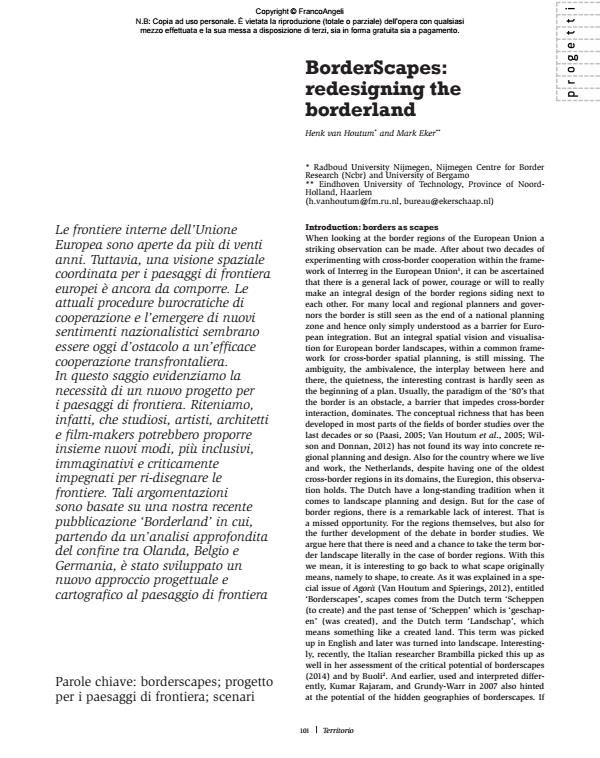BorderScapes: redesigning the borderland
Titolo Rivista TERRITORIO
Autori/Curatori Henk van Houtum, Mark Eker
Anno di pubblicazione 2015 Fascicolo 2015/72
Lingua Inglese Numero pagine 7 P. 101-107 Dimensione file 249 KB
DOI 10.3280/TR2015-072016
Il DOI è il codice a barre della proprietà intellettuale: per saperne di più
clicca qui
Qui sotto puoi vedere in anteprima la prima pagina di questo articolo.
Se questo articolo ti interessa, lo puoi acquistare (e scaricare in formato pdf) seguendo le facili indicazioni per acquistare il download credit. Acquista Download Credits per scaricare questo Articolo in formato PDF

FrancoAngeli è membro della Publishers International Linking Association, Inc (PILA)associazione indipendente e non profit per facilitare (attraverso i servizi tecnologici implementati da CrossRef.org) l’accesso degli studiosi ai contenuti digitali nelle pubblicazioni professionali e scientifiche
Le frontiere interne dell’Unione Europea sono aperte da più di venti anni. Tuttavia, una visione spaziale coordinata per i paesaggi di frontiera europei è ancora da comporre. Le attuali procedure burocratiche di cooperazione e l’emergere di nuovi sentimenti nazionalistici sembrano essere oggi d’ostacolo a un’efficace cooperazione transfrontaliera. In questo saggio evidenziamo la necessità di un nuovo progetto per i paesaggi di frontiera. Riteniamo, infatti, che studiosi, artisti, architetti e film-makers potrebbero proporre insieme nuovi modi, più inclusivi, immaginativi e criticamente impegnati per ri-disegnare le frontiere. Tali argomentazioni sono basate su una nostra recente pubblicazione ‘Borderland’ in cui, partendo da un’analisi approfondita del confine tra Olanda, Belgio e Germania, è stato sviluppato un nuovo approccio progettuale e cartografico al paesaggio di frontiera
Parole chiave:Borderscapes; progetto per i paesaggi di frontiera; scenari
- The Liminality of Subcultural Spaces: Tokyo’s Gaming Arcades as Boundary Between Social Isolation and Integration Heide Imai, Lisa Woite, in Urban Planning 6969/2024
DOI: 10.17645/up.6969 - Territorial Fragilities in Cyprus Francesco Pasta, Dafni Riga, Federico Barbieri, Wenshan Chen, Wei Lyu, pp.105 (ISBN:978-3-031-36075-6)
- Border areas and educational attainment - Long-term analysis of Hungary for the period between 1960 and 2022 János Pénzes, István Papp, Norbert Apáti, János Péter Kiss, in DETUROPE - The Central European Journal of Tourism and Regional Development /2023 pp.109
DOI: 10.32725/det.2023.015
Henk van Houtum, Mark Eker, BorderScapes: redesigning the borderland in "TERRITORIO" 72/2015, pp 101-107, DOI: 10.3280/TR2015-072016